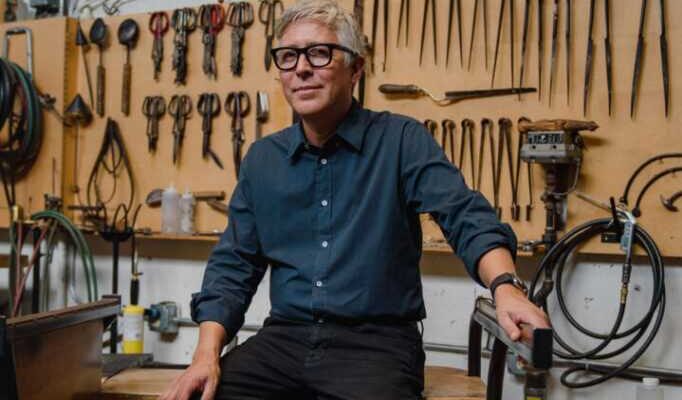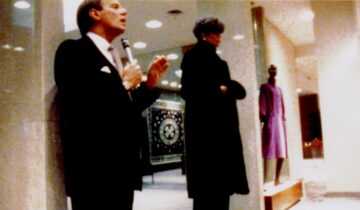By Kristen Pignuolo, Curatorial Assistant
Preston Kochéin Singletary, a Tlingit (KLING-kit) American glass artist, has a long history of incorporating his Tlingit culture into his work. Growing up in Seattle, Washington, he spent his childhood listening to stories told by his Tlingit great-grandparents. The Tlingit People are indigenous to the Pacific Northwest Coast of North America, concentrated in the area we know today as the southeast Alaskan coast.
After high school, Singletary pursued a career as a bass guitarist in several bands. In addition to performing shows in Seattle, he worked as a night watchman at the Glass Eye, a glass-blowing studio in Seattle. Singletary quickly joined one of the studio’s production teams, and, in 1984, took part in his first workshop at the Pilchuck Glass School, an international center for glass art education in Washington state. Pilchuck was founded in 1971 by Dale Chihuly along with several other glass artists. During this period, Singletary even worked as a gaffer, a master glassblower responsible for inflating and shaping the molten glass, for Chihuly, as well as assisted other prominent glass artists, such as Dan Dailey, Singletary’s high-school friend Dante Marioni, and Lino Tagliapietra—all glass artists in OKCMOA’s permanent collection.
Interested in learning more about his heritage, Singletary turned to his great-grandmother, Susie Johnson Bartlett Gubatayo, who became a source of inspiration for him and his work. A strong Tlingit woman who lived to be over 100 years old, Gubatayo was an organizer in the Seattle Tlingit community of the 1920s, a time when the Tlingit language was banned, Tlingit families were broken up, and the federal government seized Tlingit land. Singletary was inspired by his great-grandmother’s resilience and in the late 1980s began to incorporate Tlingit motifs into his work.
Growing up outside of the Tlingit community, Singletary sought out prominent Tlingit and other Northwest Coast artists and figures, such as his friend and mentor, Shdal’éiw Walter Porter, a Tlingit elder and mythologist of Yakutat, Alaska. The exhibition Preston Singletary: Raven and the Box of Daylight, opening November 11 at OKCMOA, emerged from a dialogue between Singletary and Porter about the storytelling power and potential of Singletary’s glass art as well as the foundational Tlingit story of Raven (whose Tlingit name is Yéil). Compiled from several versions of the story by curator Miranda Shkík Belarde-Lewis, PhD (Tlingit/Zuni), the multi-sensory experience tells the story of how the trickster Raven stole and released the sun, moon, and stars.
Singletary’s love of music also continues to play a role in his artistic practice. He is a founding member of the Indigenous band Khu.éex’, which incorporates Native singing, storytelling, dance, and spoken word with Rock and Funk/Jazz stylings. For Singletary, Khu.éex’ embodies what he does on a visual level with his glass art. In a conversation with Walter Porter, Singletary stated that he felt like “a musician trapped in a glassblower’s body.”
Singletary’s work is displayed museums around the world, including the Museum of Fine Arts in Boston, MA, the Seattle Art Museum, the Ethnographic Museum in Stockholm, Sweden, and the National Museum of the American Indian, Smithsonian Institution. With 40 years of glassmaking experience and working together with Tlingit elders, Singletary continues to forge connections between Tlingit culture and glass.
Photo by Jovelle Tamayo. Courtesy of the American Craft Council Library and Archives.










